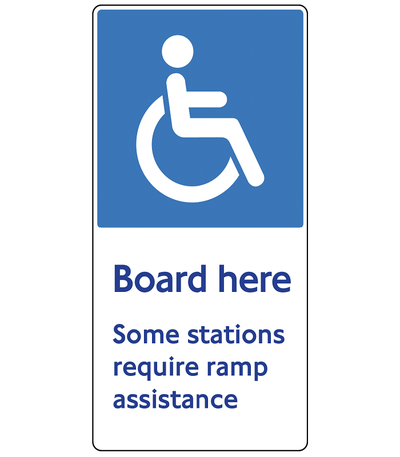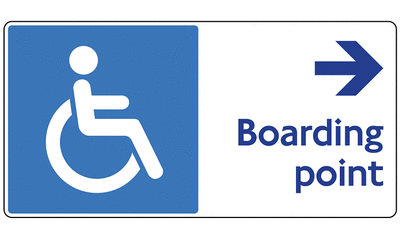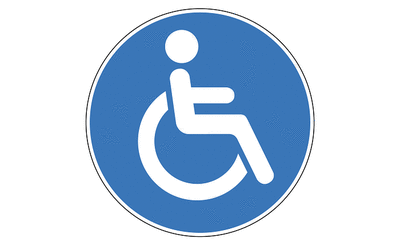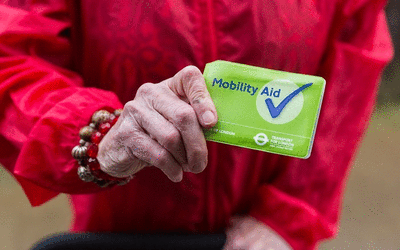Wheelchair access & avoiding stairs
- Step-free journeys
- Step-free stations and vehicles
- Lifts out of service
- Maps and guides
- Planning a step-free route
- Level access on platforms
- Boarding ramps and mini ramps
- Travel tips for using our stations safely
- Wheelchairs and mobility scooters
- Seats at stations
- Step-free consultation
Step-free journeys
We're introducing more and more step-free access, but recommend you plan your step-free route in advance and check before you travel in case of disruptions.
Watch these completely step-free journeys on our network, including Tube, bus and river services, to popular venues across London.
Step-free stations and vehicles
All our bus routes are served by low-floor vehicles, with a dedicated space for one wheelchair user and an access ramp. Buses can also be lowered to reduce the step-up from the pavement.
Around a third of Tube stations, half of Overground stations, most piers, all tram stops, the IFS Cloud Cable Car and all DLR stations have step-free access.
All 41 Elizabeth line stations are step free from street to platform. Stations from Paddington to Woolwich, and at Heathrow, are step- free from street to trains.
Many boats have boarding ramps to give step-free access.
All taxis (black cabs) have a wheelchair ramp and some private hire vehicles (minicabs) have step-free access.
Lifts out of service
If you arrive at a Tube, Elizabeth line or Overground station and the lift is unavailable, staff will help you to plan an alternative step-free journey to your destination. If there isn't a reasonable alternative route, we'll book you an accessible taxi (at our cost).
The taxi can take you to another step-free station from where you can continue your journey or to your destination station within the Greater London area - whichever is quicker and more convenient for you. This could be a could be a Tube, London Overground, Elizabeth line, DLR or National Rail station.
Maps and guides
Some step-free stations still have a gap and step between the platform and the train. The Tube map shows which Underground, Overground and DLR stations are step-free. The blue wheelchair symbol shows step-free access from street to train and the white wheelchair symbol shows step-free access from street to platform.
Step-free access from street to platform means there is a large step or gap and you will need a boarding ramp to get on and get off the train.
Step-free access from street to trains means there is a small step or gap and most customers including wheelchair users can board step-free. At some London Underground stations, there are mini ramps available to bridge the small remaining gap between the platform and the train.
Find out more about boarding ramps and mini ramps.
We also produce detailed maps for step-free journeys and avoiding stairs.
We know some customers find being underground difficult, so we have a map which shows where the tunnels are across our network.
Find accessibility guides and maps.
Planning a step-free route
Fide out how to use our travel tools to plan an accessible journey and find maps and audio/visual information when you're on the move.
Level access on platforms
An increasing number of our platforms offer step-free access onto trains.
This is provided in three ways:
Level access along the whole platform
This is available on newly built services such as the Jubilee line east of Westminster, the whole DLR network and new stations on London Overground.
Level access boarding points (platform humps)
Some of our platforms have level access boarding points. These raised platform humps make it easier for you to get on and off the train step-free.
You can find out more information about level access platforms using Journey Planner, TfL Go and the Step-free Tube guide.
Finding the boarding point
You can find the accessible boarding point using our platform signs. Look for a 'Board here' sign on the back wall of the platform. There may also be an overhead sign and floor level sign as shown here. The sign designs may vary slightly.
Always look for platform signs to find the accessible boarding point.
Boarding point position on trains
The accessible boarding point position varies by Tube line and the direction of the train.
| Tube line | Door position for eastbound and northbound trains | Door position for westbound and southbound trains |
|---|---|---|
| Bakerloo | Carriage 2 | Carriage 6 |
| Central | Carriage 6, first double door | Carriage 6, first double door |
| Jubilee | Carriage 5, second double door | Carriage 2, first double door |
| Northern | Carriage 5, second double door | Carriage 2, first double door |
| Piccadilly | Carriage 5, second double door | Carriage 2, first double door |
| Waterloo & City | Carriage 2 | Carriage 3 |
| District | Carriage 4, third door and carriage 5, first door | Carriage 4, third door and carriage 5, first door |
| Hammersmith & City | Carriage 4, third door and carriage 5, first door | Carriage 4, third door and carriage 5, first door |
| Metropolitan | Carriage 4, third door and carriage 5, first door | Carriage 4, third door and carriage 5, first door |
| Victoria | Carriage 4, third door and carriage 5, first door | Carriage 4, third door and carriage 5, first door |
Elizabeth line
If you need step-free access at any station on the Elizabeth line, it's best to board at carriage 5 where there are dedicated wheelchair spaces, regardless of whether you need a boarding ramp or not. Carriage 5 generally stops at the middle of the platform.
You can find carriage 5 by looking for blue wheelchair signs on the wall and floor.
Boarding ramps and mini ramps
Mini ramps are available at some step-free to train stations designed to cover the small remaining step or gap between the platform and the train.
Bigger boarding ramps are used to help you get on and off the train at stations where there is a larger gap between the platform and train.
See our webpage on Ramps at stations.
Travel tips for using our stations safely
We want you to be able to use our stations as safely and confidently as possible. Here's a few tips to help you:
- Make yourself known to station staff when you arrive at a station. They can check your planned step-free journey is free from disruption
- As part of our turn up and go service, staff at your departure station will be happy to arrange for you to be accompanied to the train if you wish and met by a member of staff at your destination and any interchange stations
- They can also help lay down a boarding ramp or mini ramp if you wish to use one
- If you are using a boarding ramp or mini ramp to get on or off the train, the member of staff will lay this down for you and ensure it is safely in place
- When on the station platform, look out for the wall, ceiling and/or floor signage indicating the accessible board point
- Platforms can be busy places so if you are using a motorised mobility aid, please look out for other passengers and minimise your speed
- Keep away from the platform edge and stay behind the yellow line
- While waiting on a platform for a train, position your mobility aid so you are parallel to the track, close to the back wall. If you are using a motorised mobility aid, switch it off while waiting
- As the train enters the station, if you can, raise your hand to attract the driver's attention. This lets the driver know you are on the platform and would like to get on the train. If you are with a member of staff, they will do this for you
- The accessible boarding point on the platform aligns with two sets of double doors on each train. You can get on and off the train at either set of doors
- Once the train has stopped on the platform, allow passengers to get off and manoeuvre your mobility aid to board at the double door
- Once on the train, use the brake to secure your mobility aid. As far as possible, avoid manoeuvring your mobility aid on a moving train
- There is an emergency passenger alarm at a reachable height in the accessible carriage should you need it. You can use this to speak with the driver if you need help
Wheelchairs and mobility scooters
You can use manual wheelchairs, motorised wheelchairs and some mobility scooters on many services, including buses, Tubes, trains and trams, the IFS Cloud Cable Car and some boats including Uber Boat by Thames Clippers.
Mobility scooters can't be taken in taxis and on some boats.
On buses, the wheelchair accessibility ramp is located at the exit door (in the middle of the bus). Single door buses also have an accessibility ramp.
Seats at stations
You can find seats and benches - some of which are priority seats - on station platforms and piers in some longer interchanges.
You will also find seats next to most of our station lifts.
Step-free consultation
We held a consultation on the future of the step-free Tube network from November 2021 to February 2022. A report on our findings is on the Future of step-free access on the Tube consultation page.
Find out more about future improvements and projects.




